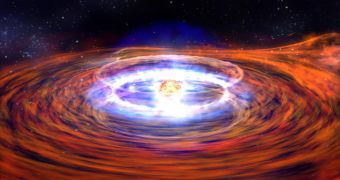Astronomers from the Massachusetts Institute of Technology, the McGill University, the University of Amsterdam and the University of Minnesota say that they were recently able to detect all the phases of thermonuclear burning processes taking place on the surface of a neutron star.
The object, commonly referred to as a “model burster,” is located relatively close-by, inside the globular star cluster called Terzan 5. This formation is located near the center of the Milky Way.
Model bursters are very “private” stars, in the sense that none was discovered until now. What its name signifies is the fact that it exploded exactly when and how computer models predicted.
The data necessary for this mission were collected by the NASA Rossi X-ray Timing Explorer (RXTE) satellite in X-ray wavelengths, and analyzed by the international team under the supervision of MIT Kavli Institute for Astrophysics and Space Research postdoctoral researcher, Manual Linares.
In addition to discovering the object itself, the new research also proposes a potential explanation for the fact that astronomers were unable to detect such a neutron star before. Details of the work will appear in the March 20 issue of the esteemed Astrophysical Journal.
“These [neutron stars] are extreme laboratories. We can study fundamental physics by looking at what happens on and around the surface of neutron stars,” Linares explains. Physicists oftentimes use these stars to study ultradense matter.
Neutron stars are produced from the collapse of massive stars that are of insufficient mass to produce a black hole. They are therefore the densest objects that we can study. A single tablespoon of matter from the surface of such an object is estimated to weigh in excess of 100 trillion tons.
Usually, neutron stars pack the mass of our Sun inside an object just 20 miles (32 kilometers) across.
The RXTE observations revealed that it is indeed possible for a neutron star to accrete matter from a companion star in a manner that enables it to sustain nuclear fusion reactions evenly throughout its surface. Previously, this was not demonstrated with direct observations.
X-ray data from the NASA telescope revealed that the star in Terzan 5 was siphoning matter from its companion, and experiencing varied effects. Mostly, small thermonuclear blasts occurred at its surface.
The frequency of such explosions depends on the rate at which the star accretes mass, but also on how far it's spinning. When the rotation-speed-to-accretion-rate reaches a certain proportion, matter flows in sufficient quantities to enable uniform nuclear reactions all over the neutron star's surface.
“We saw exactly the evolution that theory predicts, for the first time. But the question is, why didn’t we see that before?” MIT physics professor and research team member Deepto Chakrabarty explains.
One possible explanation the team thought of is that the neutron star in the Terzan 5 binary system is spinning very slowly, at a rate of just 11 rotations per second. Usually, these objects spin between 200 and 600 times per second, sometimes even twice that rate.
“That’s something that we need to look into. And now models will have to incorporate rotation, and will have to explain exactly how that physics works,” Linares explains.

 14 DAY TRIAL //
14 DAY TRIAL //